Do you know that over 1 million species are at risk of extinction? This huge number shows how very important it is to save our planet’s life forms. Picture yourself walking in a city full of tall buildings and busy roads. Suddenly, you see a rooftop garden full of bright flowers and insects. This green space among all the concrete shows how architects are helping biodiversity.
In our world today, saving the environment is key. Architects and designers are crucial in this. They are finding ways to mix city growth with protecting nature. They use things like green infrastructure and sustainable building practices. These new ideas are changing how we think about city and community planning. By including nature in our buildings, they make our spaces look good and protect important animal homes. This article will talk about why biodiversity in design is crucial, new design ideas, and how places like Ecuador and Guatemala are leading in eco-friendly construction.
Key Takeaways
- Architects and designers play a crucial role in incorporating biodiversity conservation practices into their projects.
- Innovative approaches, such as green infrastructure and sustainable building practices are reshaping the way we design cities and communities.
- Integrating nature into the built environment can create aesthetically pleasing spaces while safeguarding vital habitats and contributing to wildlife protection.
- Countries like Ecuador and Guatemala are leading the way in sustainable architecture that prioritises biodiversity conservation.
- Exploring the importance of biodiversity in design and showcasing innovative approaches to its integration is the focus of this article.
The Importance of Biodiversity in Design
Biodiversity is crucial for our planet’s health. It helps us and our environment. When designers include biodiversity in their plans, they make areas that look good and help nature. This way, they contribute to a better planet while creating beautiful, functional spaces.
Ecosystem Services and Environmental Well-being
Designing with biodiversity provides important services to us. For example, it ensures we have enough food and clean water. Biodiversity aids climate control, which is vital with today’s changing climate.
Green elements in design, like green roofs, help cool cities. They also trap harmful gases, reducing global warming. Plus, green spaces in cities control disease by supporting a variety of plants and animals.
Social Benefits and Quality of Life
Including biodiversity in designs has a wide range of benefits. It makes people feel closer to nature, which is great for mental health and life quality. Also, it offers chances for learning and fun in natural settings.
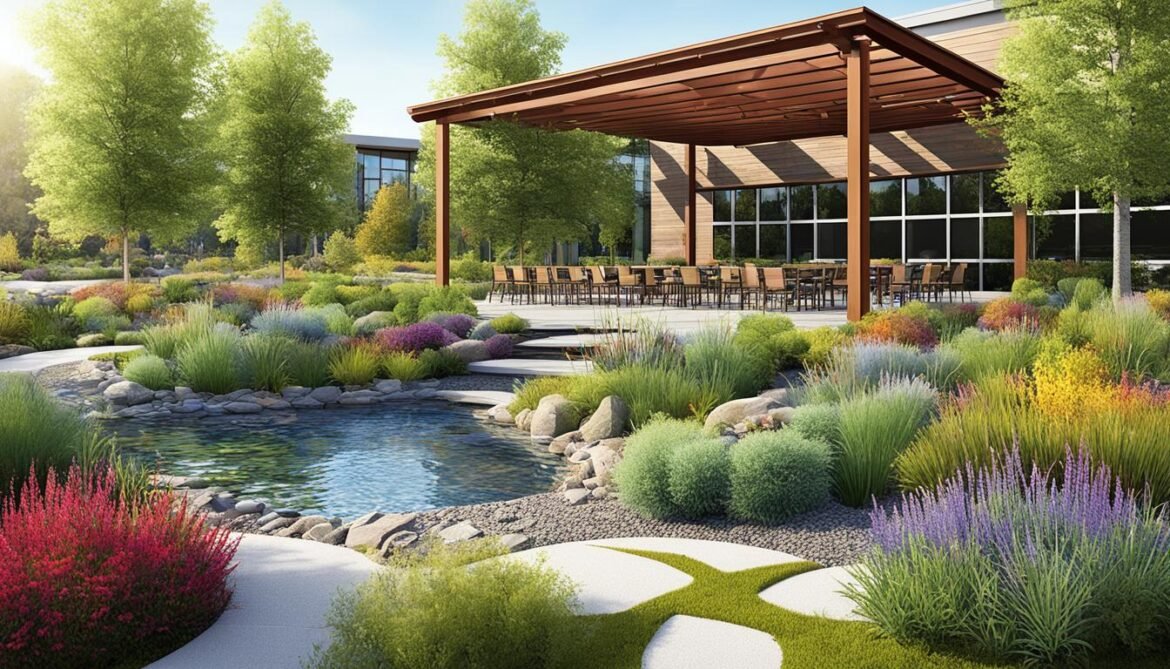
Innovative Approaches to Biodiversity Integration
Some new ways to combine nature with our buildings have appeared. These ways are making our living spaces friendlier to nature. Architects and designers are learning how to add green infrastructure and use sustainable building practices. This helps keep the homes of wildlife and makes our cities and towns better places to live.
Green Infrastructure: Embracing Nature in Design
Green infrastructure is a big part of this new thinking. It means we make more spaces for nature in our cities. Things like parks, gardens, and green roofs help animals, plants, and insects thrive. Keeping biodiversity strong in our cities is good for everyone. It also gives us nice places to relax and enjoy nature.
Making cities greener doesn’t just look good. It helps keep our planet cool. By adding plants and trees, we lower the temperature. This means we don’t need to use as much energy to stay cool. Green roofs and walls make our buildings more efficient. They also help filter rainwater, making cities cleaner and safer places to live.
Sustainable Building Practices: The Future of Architecture
Sustainable building practices are important for the planet. Architects and builders are using new methods and materials. They make sure building doesn’t harm the environment. They use renewable energy like solar power to make buildings run with less pollution.
These methods also make the places we live healthier for us. Using smart lights and good insulation makes buildings more energy-efficient. This helps cut down on carbon emissions. Builders are also choosing materials that are not bad for the planet. It all adds up to make our homes and cities better.
A Holistic Approach to Biodiversity Integration
For a real change, architects and designers should think big. They can make green spaces and paths for wildlife. They can build in ways that don’t hurt the environment. Using renewable energy and clever technology helps keep things clean. Picking materials that are kind to the earth supports a recycling-friendly world.
This way, we can have cities and homes that are good for us and nature. By working together in this big-picture way, we can make our world last longer and be more enjoyable for everyone.
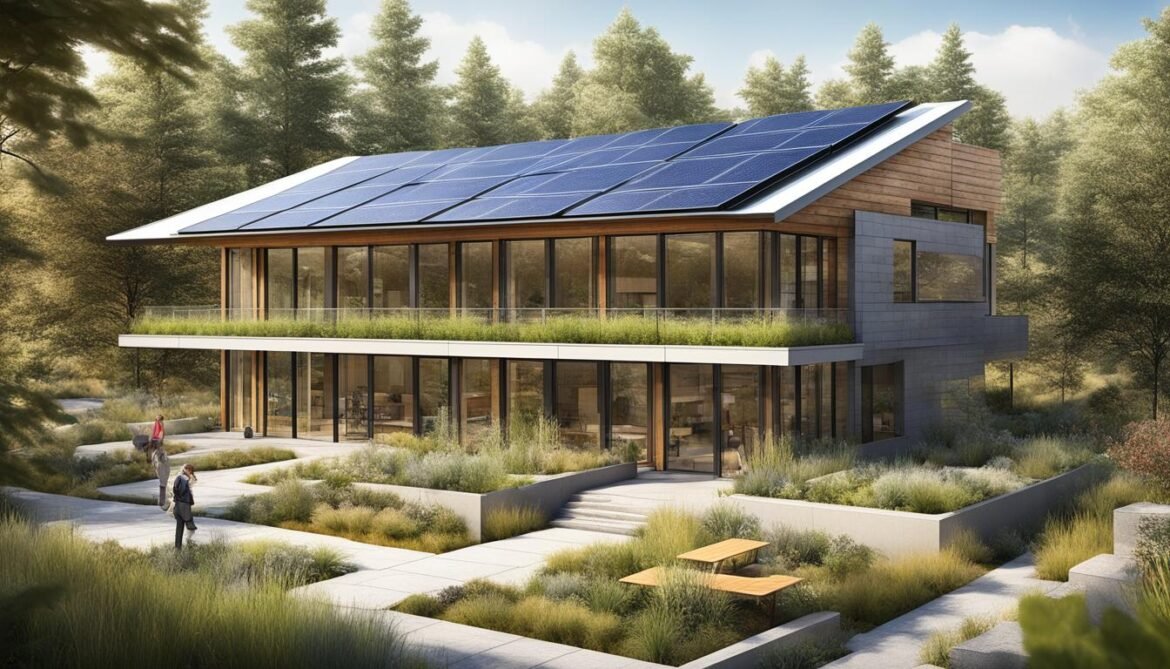
Harnessing Architectural Design for Biodiversity Conservation
Creating biodiversity integration in design is crucial today. It helps tackle environmental problems we face. With these new methods, we make buildings that help both people and the planet thrive. This is where architects and designers shine. They can design houses and cities that are good for us and nature. By focusing on biodiversity, they lead the way to a better, greener future.
Architects are now using green infrastructure and nature-based design to change our cities. This not only makes our urban areas look nicer but also helps nature. They create spaces where people and wildlife can live together, making us all happier. By including ecological landscaping in their work, they bring nature into city life in a beautiful, balanced way.
Sticking to biophilic urbanism matters a lot. It means making city designs that respect nature and people’s natural need to connect with the environment. This approach helps in creating cities that are good for everyone. It builds a sense of looking after our planet while making life better for those who live there.

The role of architectural design in biodiversity conservation keeps growing. We face big environmental issues, and design can be part of the solution. By adding nature into our buildings and cities, we can build a future that’s good for all. This way, both people and nature benefit, making a stronger, more beautiful world.
Biodiversity Conservation in Ecuador
Ecuador is famous for its rich variety of life and its dedication to protecting it. The country uses eco-friendly buildings and nature-friendly planning in its cities. This helps keep its natural beauty safe and reduces the harm from new buildings. By making sure the plans fit with nature, Ecuador keeps its surroundings healthy for plants and animals. This not only helps the Earth but also makes life better for people living nearby.
Green Infrastructure: Enhancing Biodiversity Conservation
Green spaces and careful use of resources are central to Ecuador’s green building efforts. It includes making areas for plants and animals to live and move safely. Ecuador encourages building parks, gardens, and even small forests in cities to help different species thrive.
These green areas are crucial for many types of plants and animals, helping them survive in the city. The country also connects these places with special paths for wildlife to travel, keeping nature in balance. Moreover, building with Earth-friendly materials reduces harm to the planet. It all adds up to making these projects good for the long term.
Ecuador’s focus on green space shows its full-on care for the local environment. This mix of city planning and nature protection is a model for everyone to learn from. Ecuador proves that through smart designs, we can protect the Earth’s diverse life forms.
Biomimicry in Architecture: A Sustainable Fusion
Biomimicry in architecture takes nature’s lead to make eco-friendly buildings. It looks at how organisms and natural systems work, to use these ideas in designs. This can mean copying shapes from nature, acting like animals do, and considering how whole ecosystems function.
The Concept of Biomimicry in Design and Architecture
There are two ways to look at biomimicry in design and architecture. First, there’s the direct way. This involves studying and imitating how organisms work. Second, the indirect way involves grasping broader insights and principles from nature. Then, using these deep thoughts to shape designs that are smart and alive like nature.
Potentials and Benefits of Biomimicry in Architecture and Design
Biomimicry has great potential to craft better buildings and designs. It leads to using earth-friendly materials, making smart designs, and saving energy and resources. Buildings made this way are not just pretty. They are kind to our planet, making everything work harmoniously.
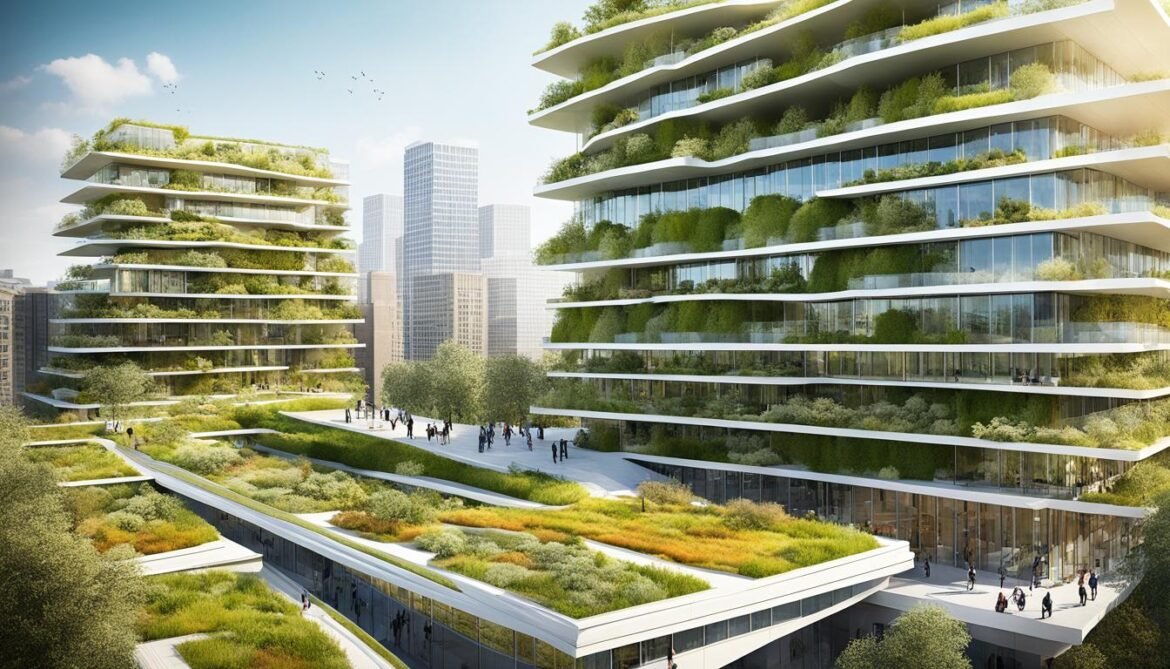
Ecological Landscaping and Biodiversity Net Gain
Good landscape design does more than make development look good—it supports nature and people working together. The Biodiversity Net Gain (BNG) laws push us to create diverse habitats in our projects. This way, nature and people can live well together thanks to smart landscape planning. It looks at the environment, the ecosystems, and designs places for everyone to flourish.
Cultivate Collaboration
Every development needs different experts. With BNG, including ecologists early helps a lot. It’s key to let landscape architects and ecologists collaborate from the start. This makes their work much more effective and ensures your project does good for nature.
Conduct Baseline Surveys
Start with detailed surveys to know the state of the land. This is crucial before any designing happens. These surveys help everyone make smart choices based on real facts.
Details Matter: Navigating the Stages of Planning
For an Outline Application, early focus is important. Build a solid start to avoid problems later. This approach makes sure all important aspects are covered well as the project develops.
Embrace Iteration
Getting BNG right takes several steps. Teamwork between landscape experts and ecologists is essential. Give enough time to test various ideas. This way, the best solutions can come out.
Strategic Ecologist Selection
Choosing the right ecologist is key. Pick ones with deep knowledge and experience with the Metric. Their work might be expensive, but it ends up saving time and money later on.
Urban Biodiversity Initiatives
Cities all over the globe are welcoming urban biodiversity initiatives. They aim to blend nature into city life. Led by experts, these efforts change how we think about creating green cities. They use Harnessing Architectural Design for Biodiversity Conservation to make cities beautiful. Besides, they bring advantages to people and nature.
In these initiatives, Green Infrastructure Planning is key. It places parks and gardens strategically in the city. These Ecological Landscaping bits improve health and cool the city. Plus, they give people places to relax, linking them to nature.
Architects and designers drive Urban Biodiversity Initiatives. They introduce Biomimicry in Architecture and Nature-Inspired Building Design. Their work fits with the environment, causing less harm. This way, the city and nature work together, promoting Habitat Conservation Architecture and making cities better places to live.
The benefits of Urban Biodiversity Initiatives are massive. They include better air, less heat, and more fun for locals. By focusing on Ecological Landscaping and Green Infrastructure Planning, these experts are key to greener, better cities.
| Urban Biodiversity Initiative |
Key Benefits |
| Green Roof Installation |
Less heat in the city, manage stormwater well, and a home for pollinators and urban animals. |
| Urban Wetland Restoration |
Cleaner water, less floods, and homes for fish and birds. |
| Vertical Gardening and Living Walls |
More green in cities, cleaner air, and a place to grow food. |
| Urban Forestry and Tree Planting |
Trapping carbon, cooler city, and nice places for people to relax. |
As cities keep growing, Urban Biodiversity Initiatives become key. Experts must work together, using Harnessing Architectural Design for Biodiversity Conservation. They help build a future where our cities and nature live in peace.
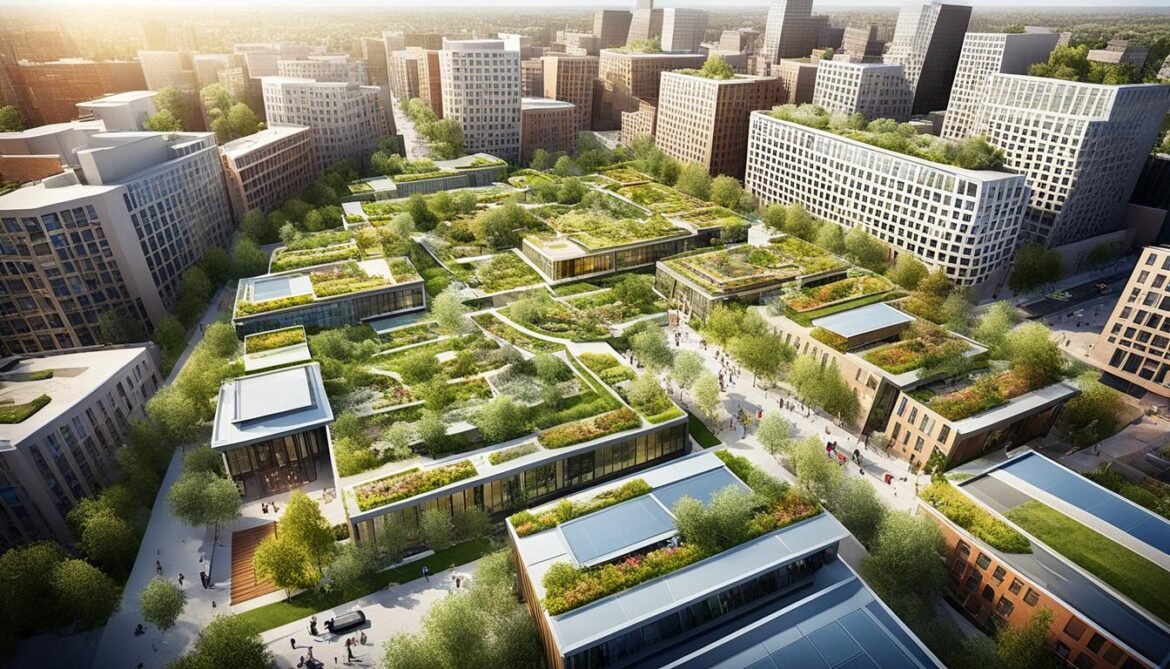
Green Infrastructure Planning and Implementation
Green infrastructure in cities and suburbs is vital for saving biodiversity. It means adding areas like parks and gardens to our surroundings. This helps plants and animals thrive, brings huge benefits, and makes communities better off.
Designers work to blend these nature spots with our buildings. They work with experts to find the best spots for these green areas. They check the area well to make sure these new places are perfect for a variety of life forms.
Such spaces are not just for animals. They are also great for us, offering places to enjoy and keeping us healthy. They help control the climate and manage rain, too. For example, special gardens and paths are used to keep our cities cooler and cleaner, and to cut down on flood risk.
We’ll look at success stories worldwide to see how green infrastructure has made cities better. We’ll see how mixing nature with our buildings has led to amazing, green communities. These communities benefit a lot from biophilia, which means living in harmony with nature.
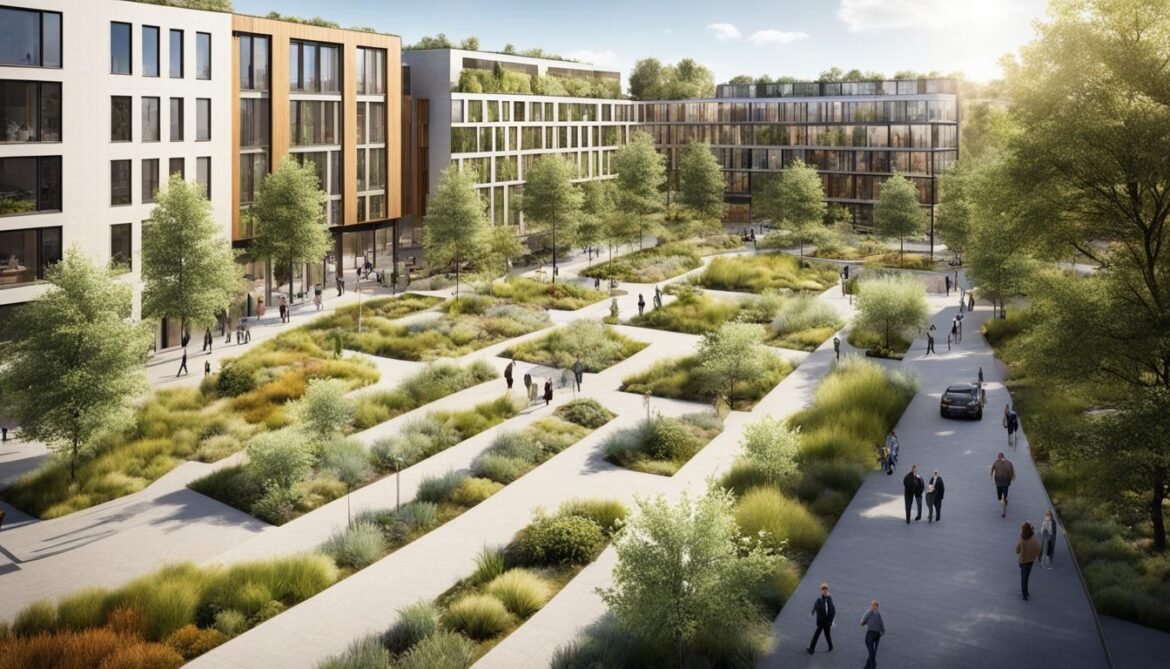
Nature-Inspired Building Design
More and more, designers look to nature for ideas. They use biomimicry to make buildings that look good and work well. This approach boosts energy efficiency, water management, and adds biodiversity to our cities.
Designers learn from nature’s structures and materials. They then make things that work like nature. For example, the lotus leaf’s cleaning ability led to buildings that stay clean. This means less energy is used for cleaning. Buildings also copy termite mounds for cooling, needing less air conditioning.
This type of design also helps nature in cities. Architects are making homes for wildlife on buildings. By copying nature, these buildings fit right into the environment. They help cities and nature live together well.
Creating cities that blend with nature is healthy and looks good. This kind of building boosts our well-being. It makes us feel good and teaches us to love nature more.
| Biomimicry Principle |
Architectural Application |
Sustainable Benefits |
| Lotus Leaf Self-Cleaning |
Building façades with water-repellent coatings |
Reduced energy consumption for cleaning, lower maintenance costs |
| Termite Mound Thermoregulation |
Passive cooling systems inspired by termite mound design |
Decreased reliance on energy-intensive air conditioning, lower carbon emissions |
| Bird Nesting Behaviour |
Architectural features that provide habitats for birds and other wildlife |
Increased biodiversity within urban areas, enhanced ecological connectivity |
By using nature in design, architects make beautiful and sustainable buildings. This use of nature boosts city life and helps the planet. Nature’s influence in building design is key in saving our environment.
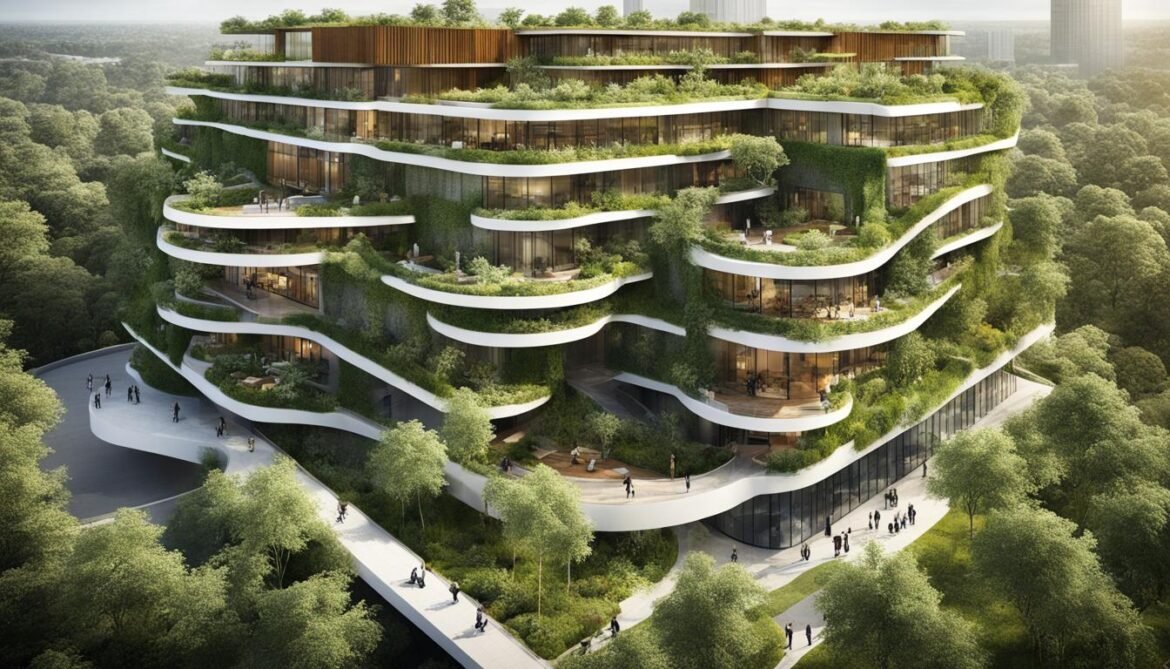
Habitat Conservation Architecture
The world is losing many species. So, habitat conservation architecture has become crucial. Architects and designers work with ecologists. They design spaces that help protect wildlife’s homes.
Nature-inspired building design is changing how we think about our cities. They add things like wildlife corridors and nesting sites. These changes are vital for our cities and the animals that live near us.
Habitat architects know that our cities should support all life. They blend nature with city living. This helps plants and animals to be part of our daily lives.
Creating wildlife corridors is a big part of their work. These green paths help animals move between urban areas. They save space for plants and animals to live.
They also make homes for animals. These include bird houses and bat roosts. It’s all part of biophilic design. Their goal is to make sure wildlife can thrive in our cities.
Architects are key in keeping our cities green. With help from ecologists, they do more than build. They make sure cities and nature work together well. This helps all of us live better, human and animal alike.
Biophilic Urbanism and Sustainable Communities
The idea of biophilic urbanism is now important. Architects and planners want to make places that link people with nature. This is about the natural human wish to be part of the natural world.
This thinking helps with people’s happiness, teamwork, and looking after the Earth. It’s all part of making communities that last.
Adding nature-inspired design and ecological landscaping to towns and cities brings many benefits. It makes places great for many forms of life. It also makes these areas more resilient and nice to live in.
Now, let’s talk about these strategies and why they’re good for communities:
| Biophilic Design Strategies |
Benefits to Sustainable Communities |
| Incorporation of green roofs, living walls, and urban forests |
Improved air quality, reduced urban heat island effect, and enhanced habitat conservation |
| Creation of nature-based recreational areas, such as parks and community gardens |
Increased opportunities for outdoor activities, environmental education, and social cohesion |
| Integration of biomimicry principles in architectural and urban design |
Improved energy efficiency, water management, and biodiversity-friendly infrastructure |
| Promotion of biophilic design features within buildings, such as natural lighting, natural materials, and views of nature |
Enhanced physical and mental well-being of residents, along with a stronger connection to the natural environment |
We’ll look at examples of places doing this well. These case studies will show how this design can help nature, provide for communities, and improve life for those living there. By using biophilic urbanism, we make places that help people and nature thrive together.
Conclusion
This article has shown how important it is to design buildings with nature in mind. By using green ideas and looking at nature for inspiration, architects are helping our planet. They are creating a future that is good for both people and the environment.
Adding nature to our buildings makes them more beautiful. It also helps plants and animals to live there. This improves the health and happiness of everyone. Architects and city planners must keep nature in their plans. This way, we can protect the wildlife around us.
When we build with nature, we all win. Our cities will be greener and full of life. By designing buildings that love nature, our communities will do better. This is how we make a happy, healthy future for everyone.
FAQ
What is the importance of biodiversity in architectural design?
Adding biodiversity to design brings many benefits. It supports essential
ecosystem services and helps regulate climate. It also boosts public health and connects people to nature, improving well-being.
What are some innovative approaches to integrating biodiversity in design?
Ways to add more nature in design include using green spaces like parks. It’s also about making buildings that are kind to the environment. Designers look at the big picture, considering biodiversity in all stages of their work.
How are countries like Ecuador leading the way in sustainable architecture and biodiversity conservation?
Ecuador stands out in green construction and nature-friendly architecture. They use eco-friendly materials and methods in their projects. By doing so, their buildings blend well with nature, helping to conserve the environment.
What is biomimicry and how is it applied in architectural design?
Biomimicry means learning from nature’s designs and systems. Architects use this to make sustainable and creative buildings. They might copy nature’s shapes or use its systems in their designs.
How can landscape architecture contribute to biodiversity net gain in developments?
Landscape architects are vital for growing biodiversity in new developments. They work closely with ecologists and pay close attention to details. By going back and forth, they make sure nature thrives in these places.
What are some examples of successful urban biodiversity initiatives?
Cities have done a lot for nature, like adding green areas and wildlife paths. These actions make air cleaner, lower the city’s heat, and offer more fun to residents. It’s a win-win for both people and wildlife.
How can architects and designers incorporate habitat conservation into their projects?
To help wildlife, designers work with nature experts. They include special areas for animals in their plans. This ensures that the places they design are good homes for all kinds of creatures.
What is biophilic urbanism, and how does it benefit biodiversity and community well-being?
Biophilic urbanism means making communities that feel close to nature. It boosts people’s happiness and care for the Earth. Also, it makes sure nature in our neighbourhoods stays healthy and thrives.
Source Links






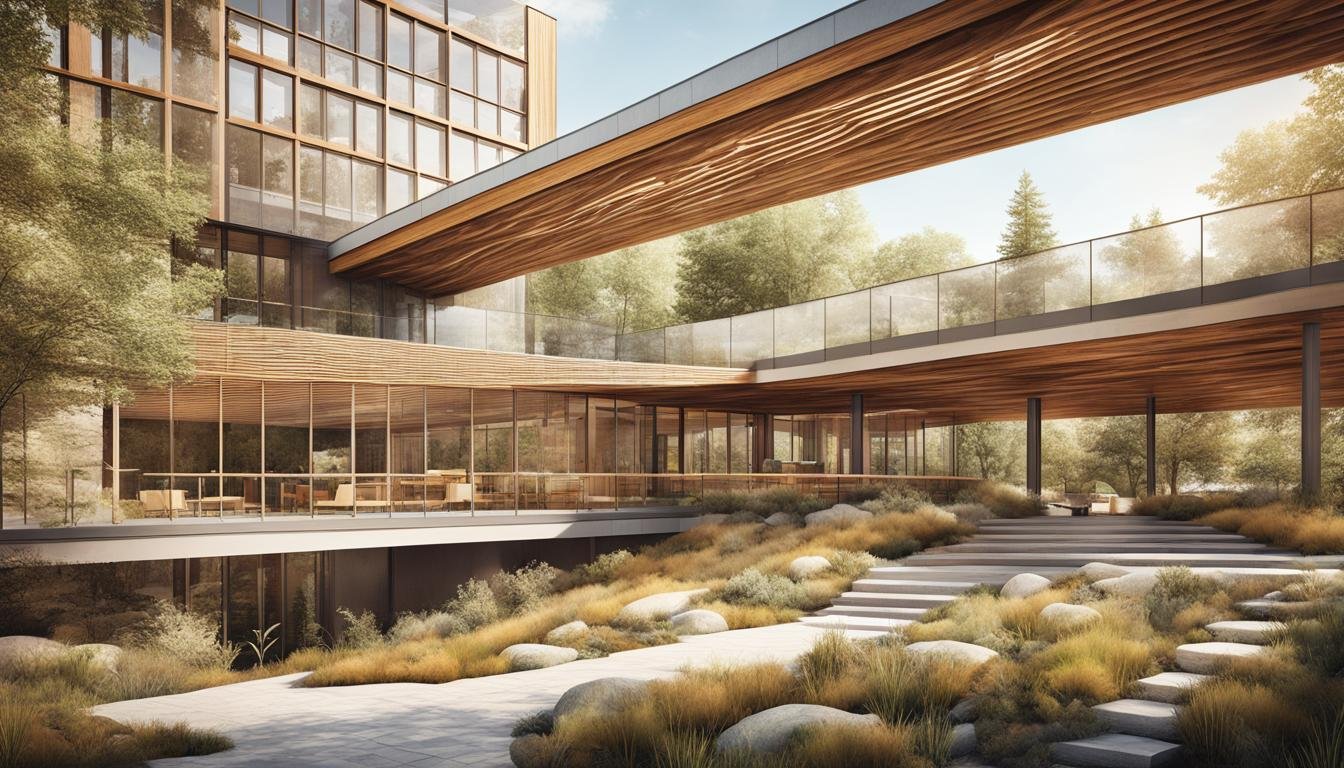







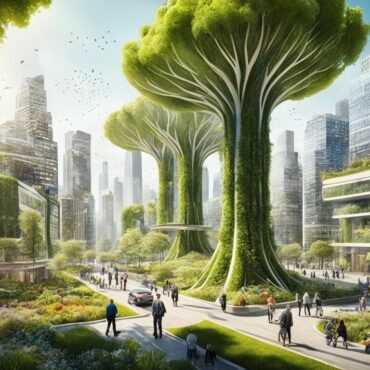
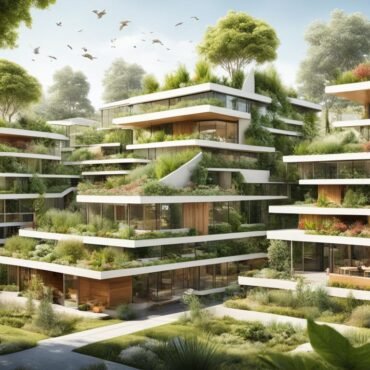









Post comments (0)